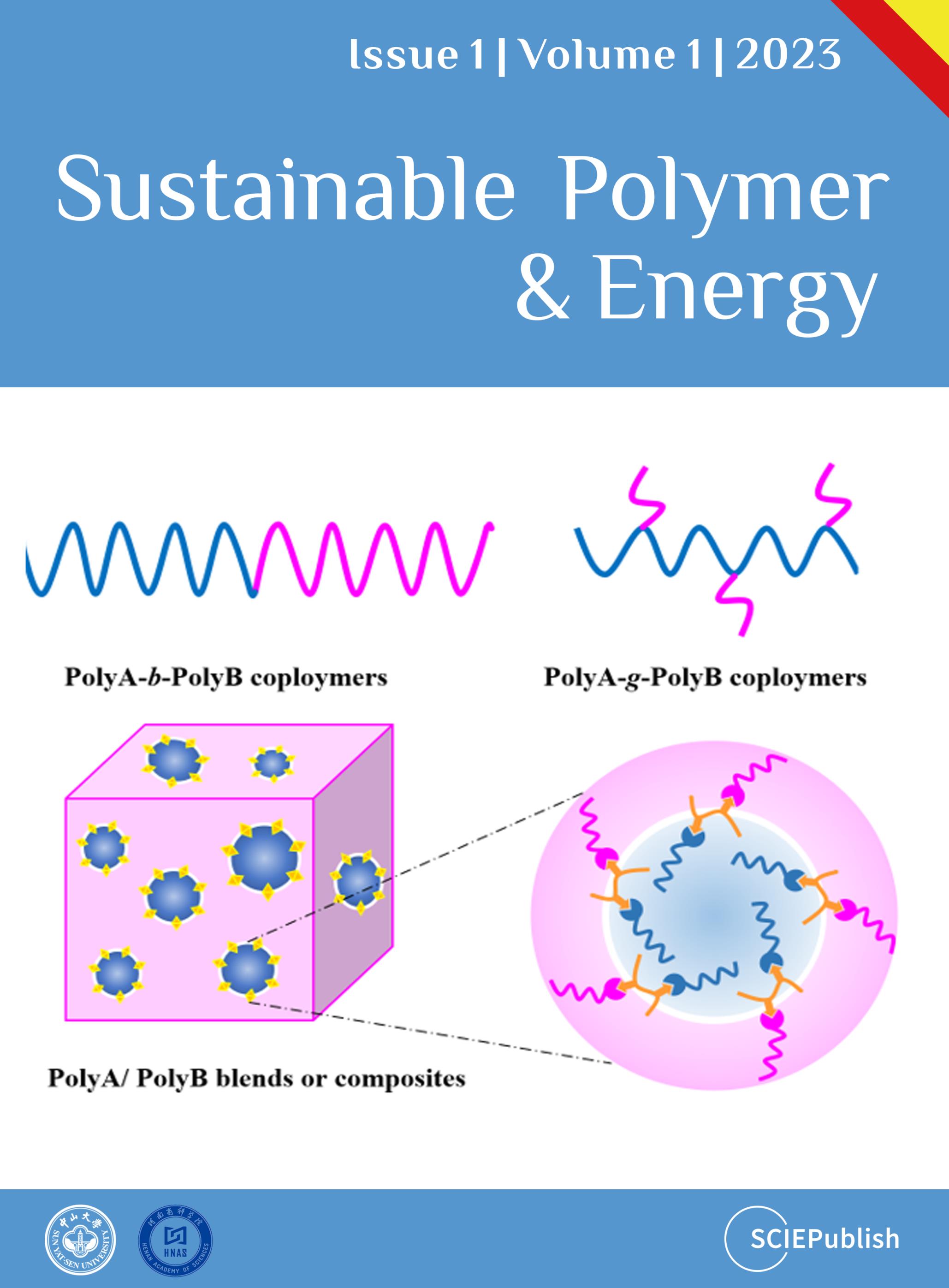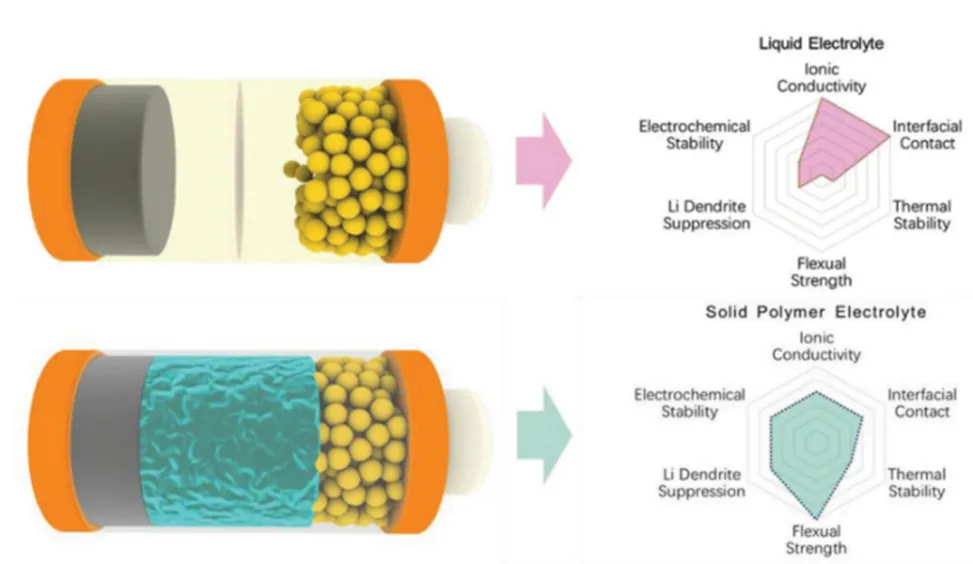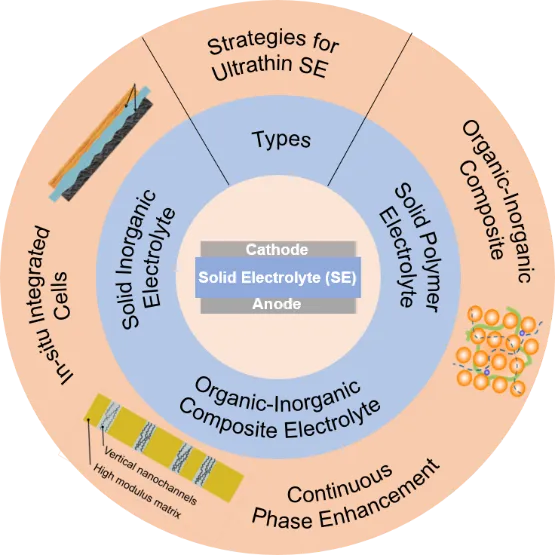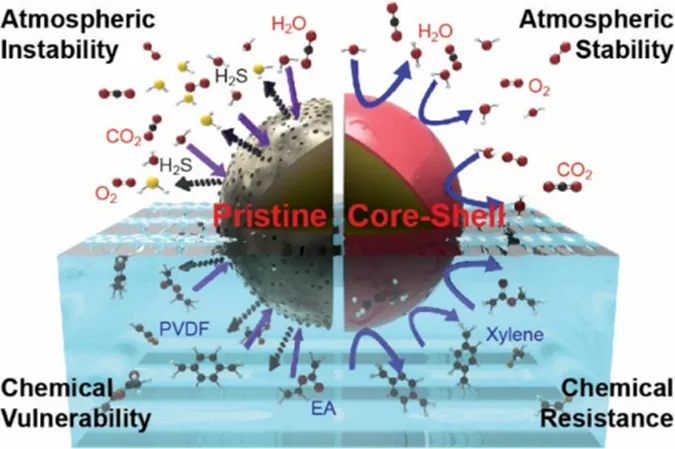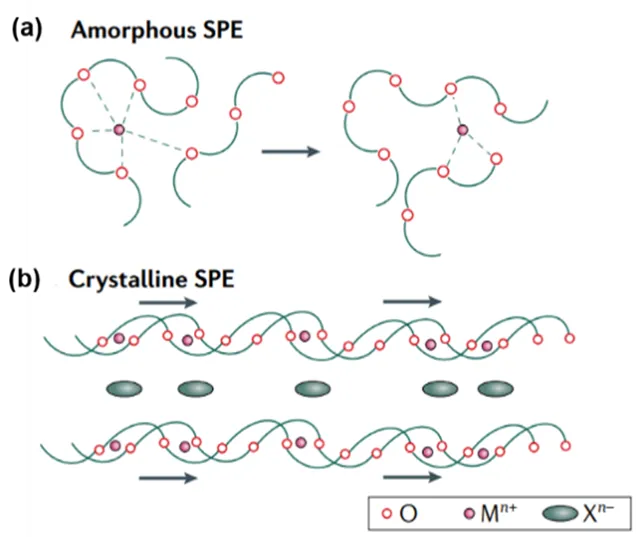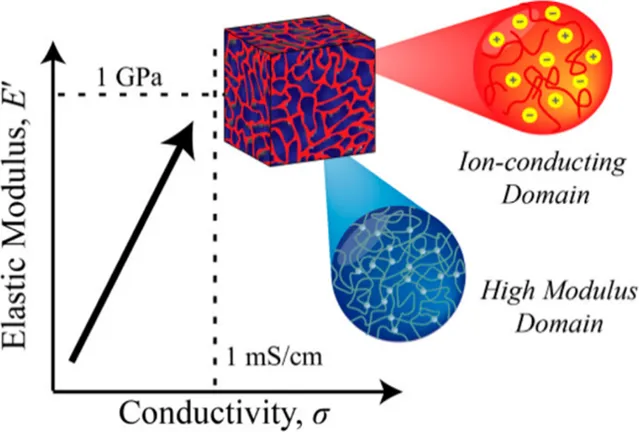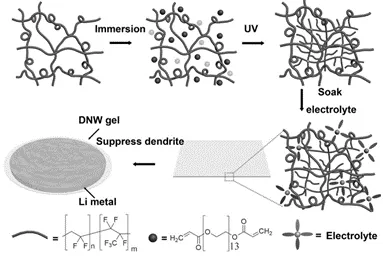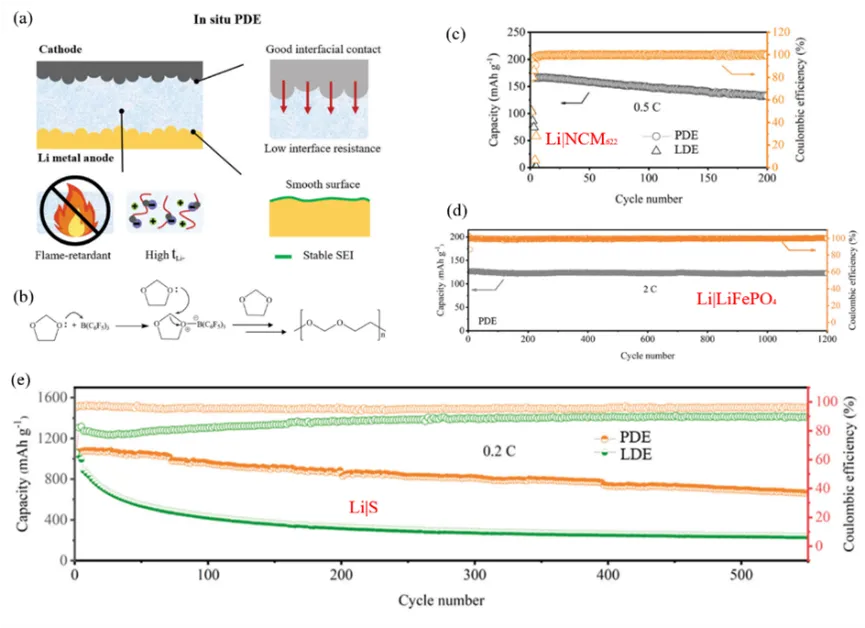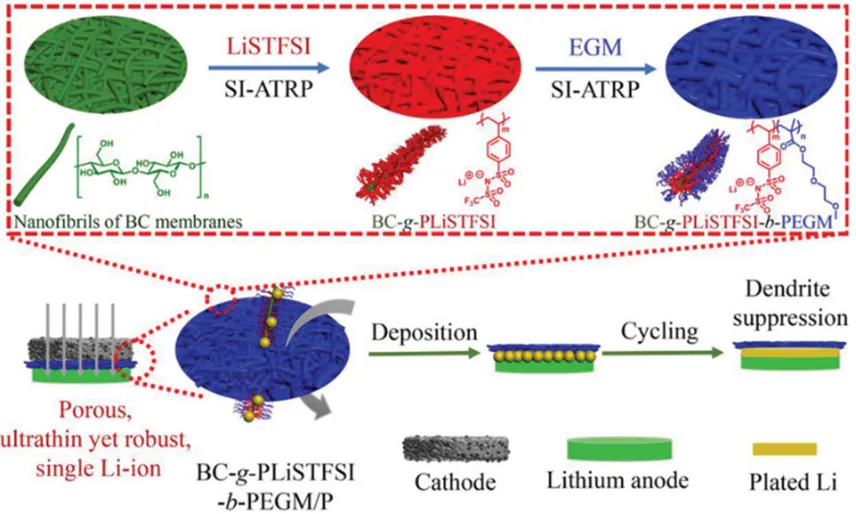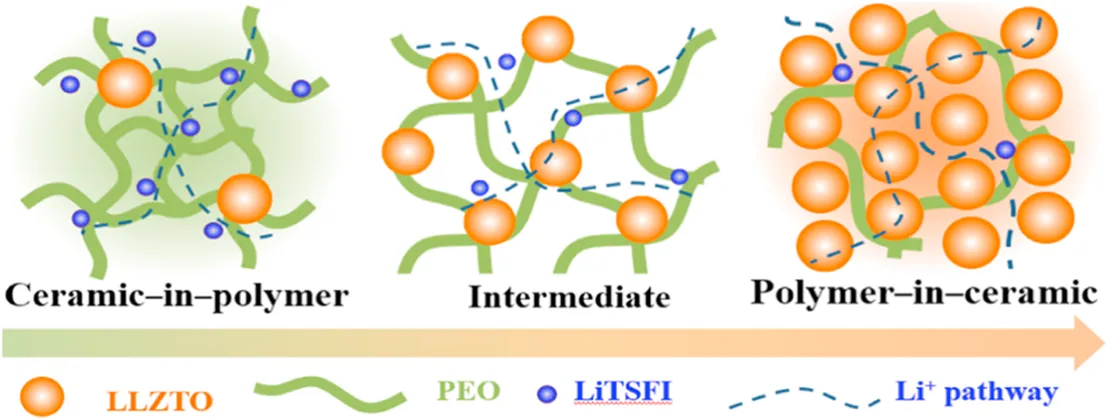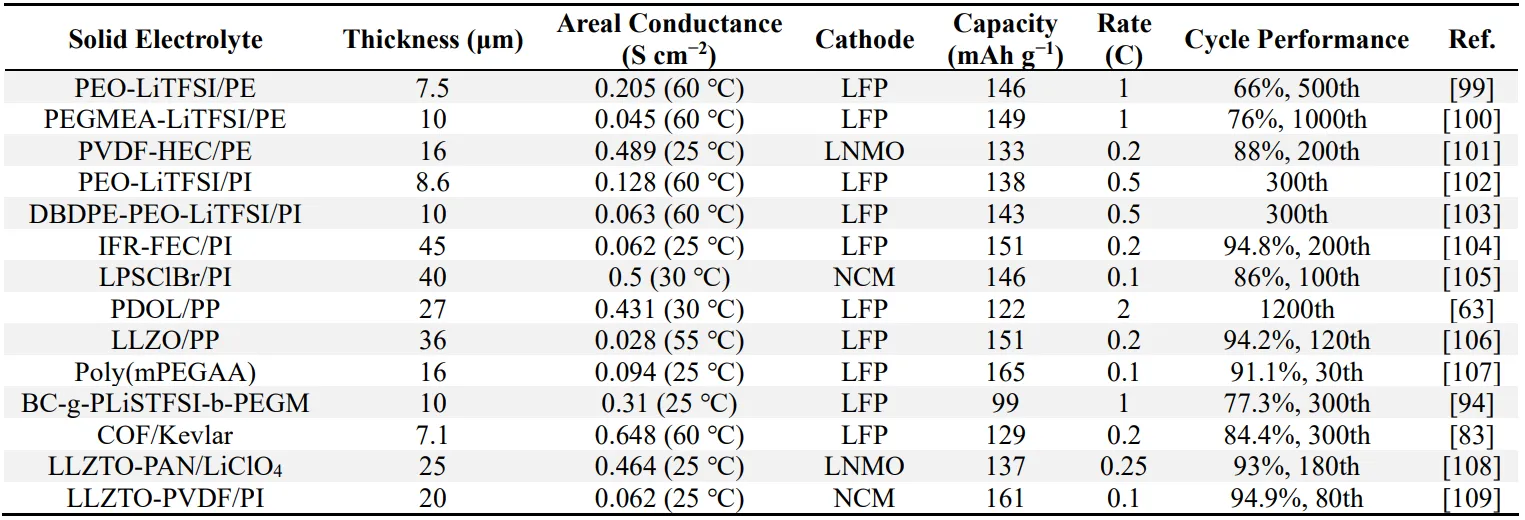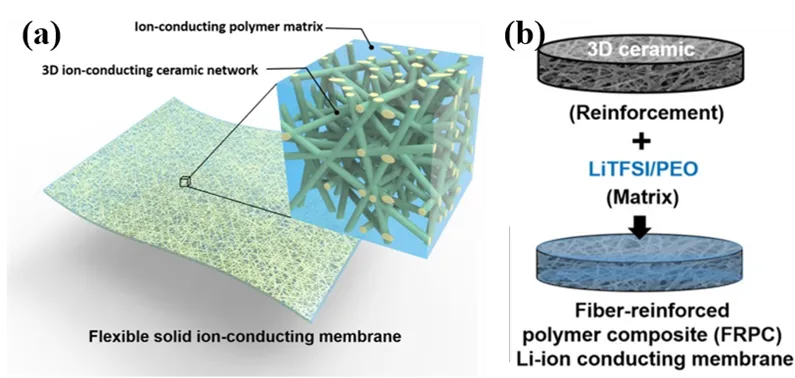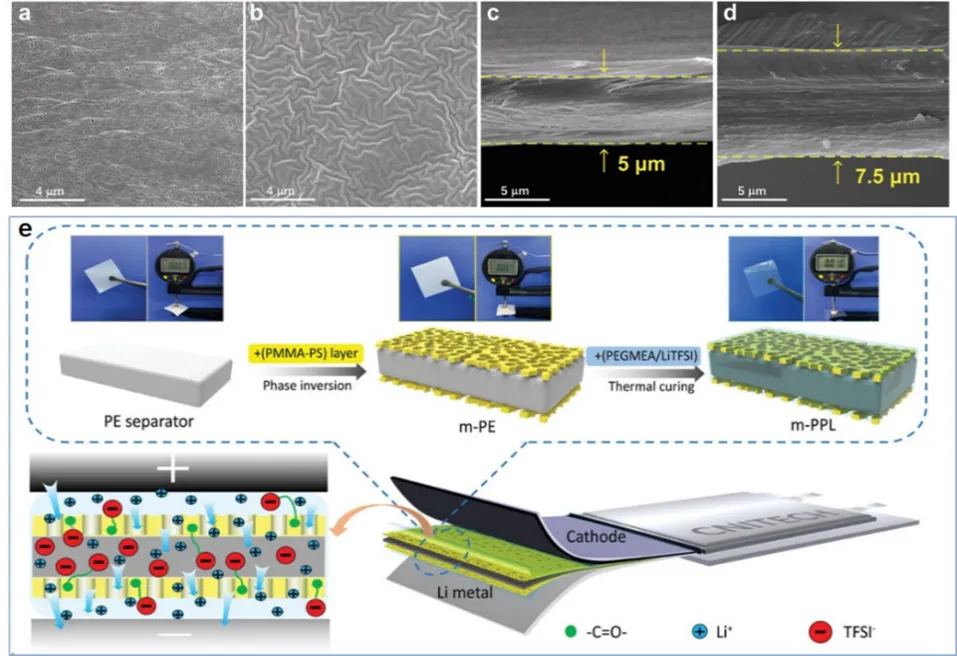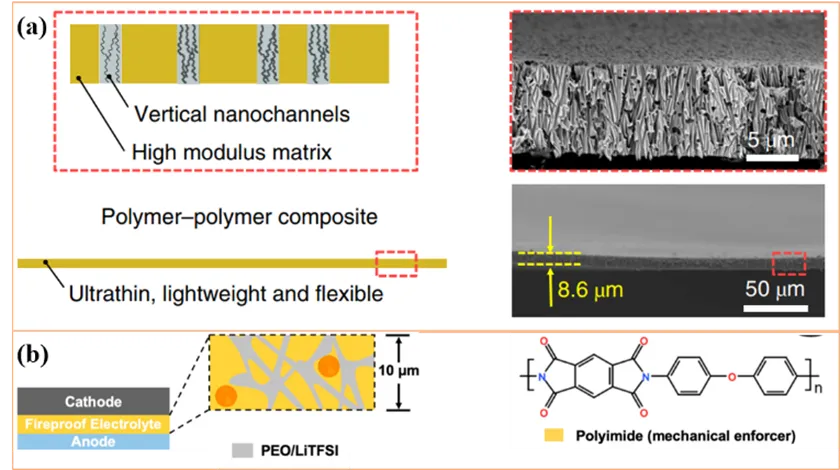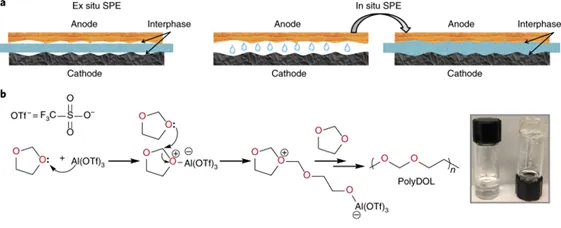Ultra-Thin Solid Electrolyte in Lithium-Ion Batteries
Author Information
Other Information
The Key Laboratory of Low-Carbon Chemistry & Energy Conservation of Guangdong Province/State Key Laboratory of Optoelectronic Materials and Technologies, School of Materials Science and Engineering, Sun Yat-sen University, Guangzhou 510275, China
*
Authors to whom correspondence should be addressed.
Received: 17 December 2022 Revised: 07 February 2023 Accepted: 27 February 2023 Published: 15 March 2023
© 2023 The authors. This is an open access article under the Creative Commons Attribution 4.0 International License (https://creativecommons.org/licenses/by/4.0/).
Sustain. Polym. Energy
2023,
1(1), 10004;
DOI: 10.35534/spe.2023.10004
ABSTRACT:
Safety
concern of lithium-ion battery, attributed to using volatile and flammable
liquid electrolytes, could be addressed by using solid electrolytes. Solid
electrolytes including inorganic solid electrolytes, polymer solid electrolytes
and organic/inorganic composite electrolytes have the common drawbacks in low
ion-conductivity. Much efforts have been devoted to increase the specific ion
conductivity, especially for inorganic solid electrolyte whose intrinsic
conductivity is close to liquid electrolyte. However, most solid-state
electrolyte membranes in lithium-ion batteries are thick, resulting in long
ion-conduction pathway, low energy density and high cost. In this review, the
advantages and disadvantages of different kinds of solid electrolytes were
analyzed, and the promising strategies of ultra-thin solid electrolyte
preparation were summarized and prospected. Applied organic-inorganic
composite, continuous phase enhancement and in situ integration have been
devoted to reducing thickness of electrolyte membrane and improving battery
performance. On the basis of the technical requirement of lithium-ion
batteries, this review aims to provide a guidance in terms of rational design
and synthesis of ultra-thin solid electrolytes for the further research that
addresses the safety issues and improves cycling performance of batteries.
Keywords:
Ultrathin solid electrolyte; Lithium-ion battery; Inorganic electrolyte; Polymer electrolyte; Inorganic-organic composite electrolyte
1. Introduction
With the development of portable devices and electric vehicles, efficient, low-price and safe electric energy storage systems are highly expected [1,2,3]. As a result, the demand for lithium-ion batteries (LIBs) is growing explosively [4]. Meanwhile, Conventional cathode materials and anode materials based on insertion mechanism have approached their theoretical capacity limit. Anode with high capacity (Li and Si) and cathode outputting high voltage are key to high-energy-density LIBs [5,6]. However, organic liquid electrolytes in lithium-ion batteries are prone to arise irreversible side reactions with the anode. Battery performance is deteriorated by continuous electrolyte consumption, and meanwhile these volatile, flammable and explosive liquid electrolytes would cause a series of safety problems including combustion and explosion [7]. Using solid electrolyte instead of liquid electrolyte is an effective strategy to solve this safety hazard (Figure 1) [8].
The electrochemical stability window of solid electrolyte is generally wider than that of liquid electrolyte, which can be adapted to cathode materials with higher voltage and thus improve the energy density of batteries. Meanwhile, a variety of solid electrolytes can be designed for different battery systems in a wide range of applications [9,10]. During the charging/discharging process, the liquid electrolyte reacts with the cathode, resulting in irreversible electrolyte loss and reducing cycle life of the battery, which do not exist in solid electrolytes. Solid electrolytes can eliminate safety problems caused by volatilization and leakage of liquid electrolyte, showing broad application prospect [11,12].
2. Solid Electrolytes
Figure 2 shows there are three types of solid electrolytes: solid inorganic electrolyte (SIE), solid polymer electrolyte (SPE) and solid inorganic-organic composite electrolyte. SIEs, such as Li7La3Zr2O12, have high lithium-ion conductivity (>1×10−4 S cm−1) at room temperature [13,14] and usually can be integrated with the cathode through high pressure to improve the interface compatibility [15]. But the pores and cracks at the interfaces of inorganic ceramic conductor block the lithium-ion conduction and lead to carrier depletion and battery polarization [16]. Out of expectation, inorganic ceramic conductors with high electron conductivity (~10−7 S cm−1) can induce the formation and migration of lithium dendrites in the ceramic [17,18]. Technically, their brittleness increases the difficulty of battery assembly.
In response, SPEs have attracted intense attentions among researchers due to their structure variety and property controllability, which can meet the different functional requirements of each component in battery [19,20]. In general, SPEs have high flexibility, light weight, low cost, and superior membrane forming property, which can be used in all components of the battery. It is worth noting that SPEs with low electron conductivity (<10−13 S cm−1) do not induce the formation of lithium dendrites, which differs from the cases of inorganic ceramic conductors [17,18,21]. However, lithium ions transport in SPEs is highly coupled with the segmental motion of the polymer chains, which often suffers from the limited ionic conductivities (<10−5 S cm−1 at room temperature) and low transference numbers of lithium ions (~0.2–0.5) [22,23]. To improve the conductivity of lithium ions, SPEs are commonly used at elevated temperatures in order to promote the segmental motion of the polymer for faster ion movement. However, increased temperature deteriorates the mechanical strength of the SPE and compromises the safety of the battery. Therefore, more attentions are captured on the organic-inorganic composite solid electrolyte [24,25]. In the composite electrolyte, the ionic conductivity and the interface incompatibility between the electrode and the solid electrolyte are significantly improved compared with the other two solid electrolytes due to the synergistic effect between the polymer matrix and the inorganic filler.
*2.1. Solid Inorganic Electrolyte*
The transport of sodium ions in β-Al2O3 (Na2O·11Al2O3) was first discovered in the 1960s and β-Al2O3 (Na2O·11Al2O3) was applied to sodium-sulfur batteries at high temperature, which was a monumental discovery in the field of solid electrolytes [26]. In 1990s, Yu et al. [27] prepared a solid electrolyte thin membrane of lithium phosphorus nitrogen oxygen (LiPON), and studied the solid electrolyte in lithium-ion batteries for the first time. Subsequently, various inorganic solid electrolyte materials have been studied, such as Li7La3Zr2O12 (LLZO), Li3xLa2/3−xTiO3 (LLTO), Li10GeP2S12 (LGPS), etc., which are generally classified as oxides and sulphides [28].
2.1.1. Ions Transport in Solid Inorganic Electrolyte
The relation of ionic conductivity with temperature in SIE can be expressed by Arrhenius equation, as shown below [29]where, *σi* is the ionic conductivity at different temperatures, *σ*0 is the pre-exponential factor, *Ea* is the activation energy, *R* is the ideal gas constant, and *T* is the absolute temperature.
In liquid electrolyte, the transport of lithium ions is achieved by the movement of solvated ions under the action of an electric field. The mechanism of ion transport in inorganic solid electrolyte is different, which is realized through the movement of lithium ions in the lattice. Thus, ion migration energy *Em* (the energy barrier at which ions diffuse from their initial position to their final position) has a big effect on ion conductivity. Meanwhile, the activation energy is also affected by the defect formation energy (*Ef*) (which depends on the number of Schottky and Frenkel defects per unit quantity of ionic conductor) and trap energy (*Et*) (the energy required by ion substitution defects) [30].
2.1.2. Oxide Solid Electrolyte
Oxide is a kind of classical inorganic ceramic electrolyte with high ion conductivity, electrochemical stability, and thermal stability, such as perovskite, NaSICON and garnet.
The perovskite crystal structure (Figure 3a) belongs to the face-centered cubic packing and can be represented by ABO3, where A is Ca, La, Mg, etc., and B is Al, Ti, etc. The ion conductivity of electrolyte can be adjusted by replacing A or B with different atoms. In general, rare-earth metal ions with large ionic radius can promote ion migration at site A, because lithium ions are located in a spatial grid composed of four adjacent oxygen ions and migrate along adjacent vacancies at site A. Although the perovskite solid electrolyte has a high ion conductivity, lithium metal can reduce Ti4+ ions to Ti3+ ions when it is embedded in the lattice [31], so perovskite needs to be modified to address this issue. For the most typical perovskite Li3xLa2/3−xTiO3 (LLTO), the ion conductivity of a single grain can reach up to 10−3 S cm−1 at room temperature [32,33], but the bulk conductivity is poor due to its large grain boundary impedance.where, *σi* is the ionic conductivity at different temperatures; As a pre-exponential factor, *σ*0 itself is a weak function of temperature, usually expressed as (*σ*0 = AT−1/2). At present, the dependence between *σ*0 and temperature is still debated [69]. *T* is the absolute temperature; *T*0 is a temperature parameter related to the glass transition temperature *Tg*, which is 50 K smaller than *Tg* numerically. *Ea* is the activation energy. For crystalline polymers, the relationship between ion conductivity and temperature follows the Arrhenius equation, as shown in Equation (1).
The main chain or side chain of the amorphous polymer matrix contains some electron-rich groups, such as -O-, -N-, -C=O, etc., which can be incorporated with the electron-deficient lithium ion. And these lithium ions can be transferred in the polymer matrix with the swing of the polymer chain. Figure 5a shows the schematic diagram of lithium ions transport in PEO-based polymer. For crystalline polymers, lithium ions conduction occurs in the ordered region formed by the polymer folded chain, as shown in Figure 5b.
Figure 2. Graphical abstract of solid electrolyte.
```latex
\sigma_i=\sigma_0\text{exp}[-\frac{E_a}{RT}]
```
Kwon et al. [34] studied the ionic conductivity of LLTO at different sintering temperatures, and the results showed that larger grains could be formed by sintering at higher temperatures, which could reduce grain boundary impedance and improve the total ionic conductivity. In addition, the LLTO with higher grain conductivity can be obtained by adding excessive lithium, which also helps to improve the bulk conductivity of perovskite.
The structural formula of NaSICON can be expressed as AM2(PO4)3, as shown in Figure 3b, where A is Li, Na, etc., and M is Ge, Ti, Zr, etc. Ions are transported in a skeleton constructed of two MO6 octahedra and three PO4 tetrahedra [35]. NASICON solid electrolyte has high ion conductivity, good electrochemical stability and high air stability, but it also has the problem of low total ion conductivity due to high grain boundary resistance. LiTi2(PO4)3 has the most suitable lattice size for lithium-ion transport, with relatively high ion conductivity. When Al3+ is used to replace part of Ti4+ ions (LATP), the *Em* of ions can be reduced and the ion conductivity can be improved [36]; when Ge4+ is used to replace Ti4+, the Ti-free electrolyte (LAGP) has a good compatibility with lithium metal [37].
Figure 3c shows the structural formula of garnet-type solid electrolyte Li5La3M2O12, where M is Ta, Nb, Zr, etc. [29]. This kind of electrolyte has a good compatibility with lithium metal, excellent ion conductivity, high electrochemical and thermal stability, but it suffers from poor air stability and the interface impedance between electrolyte and electrode is relatively large [38]. LLZO is the most studied garnet solid electrolyte, which can be divided into cubic phase and tetragonal phase according to the crystal structure. The cubic phase has high ionic conductivity, while the LLZO of tetragonal phase has relatively low ion conductivity due to the complete regular arrangement of lithium ions. The lattice size can be adjusted by doping with other ions to improve the ionic conductivity of LLZO. Buannic et al. [39] replaced part of Li+ and Zr4+ with Ga3+ and Sc3+ by the double-doping strategy. The substituted Ga3+ at the Li+ site can stabilize the cubic crystal structure, while the partially filled Sc3+ at the Zr4+ site not only increases the number of carriers, but also enhances the disorder of Li+, resulting in the increase of local mobility of lithium ion. With this optimization, the ionic conductivity increases from 1.1×10−3 S cm−1 to 1.8×10−3 S cm−1 at room temperature.
2.1.3. Solid Sulfide Electrolyte
There are more freely mobile Li+ in the sulfide crystal because S2− is less electronegative than O2− and has less binding affinity with Li+. In the crystal lattice of solid sulfide electrolyte, S2− with a larger radius can form a larger ion transport channel, showing a higher ionic conductivity than oxide, and ionic conductivity of some sulfides even exceeds that of commercial liquid electrolytes. Sulfide has excellent thermal and electrochemical stability. However, during their preparation, sulfides react with water produce highly toxic H2S gas, resulting in environmental challenges that remain to be addressed. Moreover, an additional difficulty may occur in sulfides electrolyte: most sulfide tend to decompose rapidly upon contacting with lithium metal.
Li2S-P2S5 (LPS) is the most studied sulfide solid electrolyte system, whose ionic conductivity is related to the preparation method and the Li2S/P2S5 ratio. Hayashi et al. [40] used mechanical grinding to obtain 75Li2S-25P2S5 (mol%) amorphous sulfide electrolyte with ionic conductivity of 2.0 × 10−4 S cm−1 at room temperature. Based on the principle that grain boundaries are eliminated by heat treatment, Seino et al. [41] successfully prepared 70Li2S-30P2S5 (mol%) ceramic sulfide electrolyte with ionic conductivity as high as 1.7 × 10−2 S cm−1, which exceeded the ionic conductivity of some liquid electrolytes.
To solve the problem of air instability of sulfide electrolyte, there are mainly the following methods: (1) adding metal oxide, metal sulfide, lithium halide or zeolite as additive to sulfide in order to absorb or inhibit H2S and reducing the reaction between electrolyte and air [42,43]; (2) replacing P with elements that bond more stably with S (such as As, Sn, etc.) [44] because the instability of sulfide in humid air is caused by the instable P-S bond; (3) Partially replacing S2− in sulfide with O2− , which can improve the stability of S2− in natural environment because O2− can form a closer bond with P5+ [45,46]; (4) as shown in Figure 4, the electrolyte particles coated with a barrier layer can avoid direct contact between air and electrolyte to improve the stability of electrolyte [47,48].
*2.2. Solid Polymer Electrolyte*
The origin of polymer electrolytes dated back to a report on complexes of alkali metal ions with polyethylene oxide (PEO) in 1973 [49]. Then, in 1979, Farrington et al. [50] reported the good membrane-forming properties of PEO-alkali metal salt complexes and their use as electrolytes in lithium-ion battery at higher temperatures, which started the era of solid-state battery research. In general, polymer matrix and lithium salts are combined to form SPE, in which lithium salts such as lithium hexafluorophosphates (LiPF6) [51], lithium perchlorate (LiClO4) [52], lithium difluoromethyl sulfonimide (LiTFSI) [53], lithium difluoromethyl sulfonimide (LiFSI) [54], etc., provide mobile lithium ion. Polymer matrix such as PEO [55,56,57], polyvinylidene fluoride (PVDF) [58,59], polycaprolactone (PCL) [60], polymethyl methacrylate (PMMA) [61,62], polydioxentyl ring (PDOL) [63,64,65], etc. is used as a medium to facilitate lithium-ion migration. Compared with inorganic solid electrolyte, SPE has the advantages of small electrode-electrolyte interface, good mechanical properties, high flexibility, etc., but the ionic conductivity is generally low at room temperature, which can be improved under higher temperature. Therefore, the battery using solid polymer electrolyte can work at high temperature. An appropriate amount of small molecule plasticizer can also be added to the polymer matrix to improve the ion conductivity, so that the battery can work at room temperature, which is called gel polymer electrolyte or quasi-solid polymer electrolyte, and it is recognized that the ionic conductivity of this kind of electrolyte should be higher than 1×10−4 S cm−1 [29,66,67].
2.2.1. Ion Transport in Solid Polymer Electrolyte
The relationship between ionic conductivity and temperature of amorphous polymers can be expressed by the Vogel-Tamman-Fulcher (VTF) equation, as shown below [68]
```latex
\sigma_i=\sigma_0\text{exp}[-\frac{E_a}{R(T-T_0)}]
```
2.2.2. All Solid Polymer Electrolyte
Among all the polymer electrolytes, PEO is an excellent transporting medium for lithium ion due to its chemical structure of H-(O-CH2-CH2)n-OH [49,50,70,71]. Molecular weight above 20,000 g mol−1 is called polyethylene oxide (PEO), while molecular weight below 20000 g mol−1 is called polyethylene glycol (PEG) [67]. PEO is a semi-crystalline polymer, and the ionic conductivity of PEO-lithium based polymer electrolyte is on the order of 10−6 S cm−1 at room temperature. As mentioned in the previous section, lithium-ion conduction mechanism of PEO is different in crystal region and amorphous region, and it is generally believed that amorphous region can conduct lithium ion more quickly [68]. Numerous strategies have been developed to mitigate this disadvantage, such as raising the battery working temperature (>50 °C), and adding plasticizers, inorganic ion conductors or other high strength polymers.[72,73,74] However, these proposed solutions resolve the problem of lithium-ion conductivity at the expense of the mechanical strength (for adding platicizers) or increasing interface quantity (for adding inorganic ion conductors or other high-strength polymers), and increasing the thickness of electrolyte membrane to compensate the reduced mechanical strength will increase the internal resistance of the battery, and thus the PEO-based SPEs are still plagued by a incongruity of the ionic conduction and mechanical strength triggered. In addition, since the ion conduction in the amorphous region of the polymer is realized through the swing of the chain segment, it is also necessary to reduce the glass transition (*Tg*) of the polymer to improve the kinematic ability of the chain segment.
Copolymerization [75,76,77], cross-linking [78,79], blending [80,81], organic-inorganic composite [82,83] and other methods can reduce the crystallinity and *Tg* of polymer, and improve the mobility of the chain segments, among which copolymerization is a more effective method. The introduction of other monomer units into the polymer system can destroy the ordered structure of the polymer matrix and increase the proportion of amorphous regions. Copolymers can be classified into alternating copolymers, random copolymers, graft copolymers, and block copolymers according to the way the copolymer units are arranged along the polymer chain. Block copolymers can be designed with one block responsible for ion conduction and another block providing mechanical strength. Lv et al. [84] prepared a high-voltage cyanide-SPE with a good oxidation stability and a strong polarity by in-situ copolymerization of 2-cyanoethyl acrylate (CA) and polyethylene glycol methyl ether acrylate (PEGMEA). The CA not only improves the mechanical strength of the SPE, but also increases oxidation resistance due to its strong polarity and high-pressure stability, while PEG is responsible for providing ion conduction. The LiCoO2 battery with the cyanide-SPE can stably charge/discharge more than 1000 cycles at 0.5 C.
The copolymer SPE with microphase separation structure can be obtained by controlling the ratio of reactants and other conditions. The two phases play the functions of ion conduction and structural support respectively. Schulze et al. [85] dissolved the macromolecule chain transfer agent of PEO in the mixture of ionic liquid, styrene and divinylbenzene, and then obtained a bicontinuous polymer electrolyte membrane with highly crosslinked polystyrene and PEO/ionic liquid interpenetrating nanostructures by heat. As shown in Figure 6, this SPE exhibits the elastic modulus of close to 1 GPa and the ionic conductivity higher than 1 mS cm−1 at room temperature.
2.2.3. Gel Polymer Electrolyte
Gel-polymer electrolyte has relatively high ionic conductivity due to the presence of small molecule plasticizers, which can exceed 10−4~10−3 S cm−1 at room temperature, and has a good compatibility with electrodes, but suffers from low thermal stability, poor mechanical properties, and low safety compared with SPE [86]. In gel polymer electrolytes, the ions transport usually occurs in the liquid phase, and the polymer matrix mainly provides mechanical strength and maintains the three-dimensional stability of the electrolyte [87]. Based on this, the polymer matrix is expected to have good membrane formation, high strength, creep resistance and other properties. Wu et al. [88] synthesized a double-network gel polymer electrolyte by using the two-step method shown in Figure 7. An interpenetrating network polymer membrane with high mechanical strength was first synthesized and then immersed into the electrolyte to form a gel electrolyte. At room temperature, the ionic conductivity is 8.1×10−4 S cm−1, and the tensile strength can reach 10 MPa. The gel electrolyte used in batteries can be stably charged and discharged for more than 250 cycles.
Traditional gel polymer electrolytes still have safety problems, so it is very important to develop gel polymer electrolytes with flame retardant function. It is a simple method to prepare flame-retardant gel electrolyte by directly adding some flame-retardant substances into plasticizer. Xiang et al. [63] used the initiator tri (pentaphenyl) borane (TB) with flame retardancy for synthesizing polydioxentyl electrolyte, and the as-prepared electrolyte could not be ignited as shown in Figure 8a,b. In addition, *in situ* synthesis method greatly reduced the interface impedance between electrode and electrolyte. The gel electrolyte used in Li|NCM622, Li|LiFePO4 and Li|S batteries (Figure 8c–e) [63], all showed the excellent performances.
The above gel polymer electrolyte is a two-ion conductor in which both lithium ion and anions can move in the matrix. Lithium ion moves relatively slower in the polymer than the anion due to the complexation of lithium ion with the polymer, resulting in low lithium-ion transference numbers [89,90]. During the charge and discharge processes, both lithium ion and anions move towards the electrode, but the anions accumulate near the electrode rather than depositing onto the electrode, resulting in the concentration polarization, which will lead to the increase of battery internal resistance and the decrease of discharge platform [91,92]. The anions of the single-ion conducting polymer electrolyte (SCPE) are fixed on the polymer chain in the form of covalent bonds, and only lithium ion can move back and forth in the electrolyte under the action of electric field, which makes the *t*Li+ close to 1 [93]. However, SCPE cannot act independently as solid electrolyte (*σ* < 10−5 S cm−1), due to its relatively low molar amount of lithium ion, but it can be used as a part of the composite SPEs to transfer lithium ions in coordination with other SPEs with high molar amount of lithium ion. Simply adding a large amount of plasticizer to improve the ionic conductivity of SCPE will increase the safety risk of the battery. It is feasible to improve the intrinsic ion conductivity of SCPE through the rational design of the polymer structure and reduce the amount of plasticizer for enhanced safety of the battery.
Zhou et al. [94] grafted polymers onto the side chains of nanobacterial cellulose and synthesized a brush-like single-ion conductor polymer electrolyte membrane with a thickness of 10 μm, as shown in Figure 9. The SCPE membrane with 25% of DOL/DME shows an ionic conductivity of 3.1×10−4 S cm−1 and Young's modulus of 1.9 GPa. And the Li|SCPE|LFP battery exhibits a good cyclic stability of 84% retention after 350 cycles at 0.5 C.
*2.3. Organic-Inorganic Composite Solid Electrolyte*
The optimization of polymer chain structure can improve the ionic conductivity of SPE, but it is still not as good as that of inorganic solid electrolyte. Although the ionic conductivity of gel polymer electrolyte has been greatly improved, its mechanical strength is poor. The combination of polymer and inorganic filler can combine the advantages of multi-component materials, so that the mechanical strength and ionic conductivity of solid electrolyte can be well improved. Based on the capability of inorganic fillers for conducting ions, they can be divided into inert fillers (such as Al2O3, MgO, etc.) and active fillers (such as LLZO, LiAlO2, etc.) [95]. Inert fillers do not participate in ion transport in solid electrolyte and only play a role in reducing crystallinity. The active fillers can not only reduce the crystallinity of the polymer, but also participate in the ion transport of the solid electrolyte [20]. The three structures of “ceramic in-polymer”, “polymer in-ceramic” and “intermediate” (double continuous phase) can be formed by adjusting different proportions of the active filler [96]. Figure 10 shows the structure of three formed compound solid electrolytes with different proportions of LLZTO and PEO.
3. Ultra-Thin Solid Electrolyte
The ionic conductivity of solid electrolyte over 10−4 S cm−1 is a basic requirement for the normal operation of batteries, but most of the reported solid electrolytes do not meet this requirement [8]. The ionic conductivity of the electrolyte is related to the temperature, and at a given temperature, the ionic conductivity is determined. According to the calculation formula of the ionic conductivity (Equation (3)), the smaller the membrane thickness is, the smaller the ohmic impedance of the electrolyte membrane will be, so thin membrane is more conducive to improving the battery performance.where *σ* is the ionic conductivity of the electrolyte, *l* is the membrane thickness, *R* stands for the bulk resistance, and *S* represents effective area of the membrane.
This property can be defined by surface conductivity (*σs*) as the following Equation (4).where *σs*, *σ* and *l* represent the surface conductivity per unit area, ion conductivity and thickness of the electrolyte membrane, respectively.
Table 1 lists the reported thin electrolyte membranes and the corresponding cell performance. At present, the thickness of SPE membrane is generally more than 100 μm, and the thickness of solid inorganic electrolytes (SIEs)membrane exceeds 200 μm. If the thickness is reduced to about 10 μm, the ohmic impedance can be decreased by more than 10 times, and the surface conductivity can be improved by 10 times. In this case, even if the ionic conductivity does not reach the standard of 10−4 S cm−1, the battery can still operate normally due to a small internal resistance. In addition, reducing the thickness of the electrolyte membrane leads to less weight of the battery, which can reduce the battery cost, and improve the mass energy density and volume energy density of the battery, so the ultra-thin solid electrolyte (thickness < 20 μm) is an important avenue for future battery development [28,97,98]. Preparation of ultra-thin solid electrolytes is difficult: inorganic electrolytes are brittle, and thin electrolytes are easy to break during battery assembly; and the strength of polymer electrolyte is poor, and the thin electrolyte membrane is prone to be damaged, resulting in short circuit in the battery. There are several strategies to reduce the thickness of electrolyte membrane.*3.1. Organic-Inorganic Composite*
Adding appropriate amount of organic material to form organic-inorganic composite electrolyte can overcome the brittleness of inorganic material to enhance the flexibility and reduce the thickness of the electrolyte membrane. In the composite electrolyte, the inorganic material dominates the conduction of lithium ions, and the polymer plays the role in stabilizing the structure. Some reports directly use polymers as binders in SIEs to endow the composite with certain solubility.
Riphaus et al. [110] prepared a series of sulfide and polymer solid composite electrolytes by solvent method. The thickness of the electrolyte membrane was 50–100 μm with 5 wt% binder, and the thickness could be reduced to 20–40 μm with 10 wt% binder. This method can improve the mechanical properties of inorganic materials to a certain extent, but the continuous phase structure cannot be formed with the addition of small amount of polymer, which makes it difficult to obtain a thinner composite electrolyte membrane. If the thickness of such composite electrolyte membrane is thinner, the flexibility of the membrane will become worse and ruptured, which will affect the battery performance. Organic-inorganic dual continuous phase structure is conducive to obtaining a thin electrolyte membrane and shows a good battery performance. Fu et al. [111] prepared a solid electrolyte membrane with a thickness of 40 μm using LLZO-PVP membrane as the support and PEO-LiTFSI as the filler (Figure 11).
Because of the continuous ceramic phase structure, the surface conductivity of the electrolyte membrane was 0.063 S cm−2 at room temperature. The assembled Li|Li symmetrical battery exhibited a stable cycling for more than 1000 h at 0.5 mA cm−2 at room temperature.
The mechanical strength of the solid composite electrolyte membrane prepared by the polymer as framework material is better than that of inorganic counterpart. Hu et al. [108] prepared a composite electrolyte membrane with a thickness of 25 μm by combining electrostatic spray and electrospinning technology, and then attached the lithium salt to the surface of the fibers and particles by solution method. As shown in Figure 12, the surface conductivity of the electrolyte membrane is 0.464 S cm−2, the Li|Li symmetrical cell demonstrates a stable cycling performance during Li plating/stripping, lasting more than 5000 h at 1 mA cm−2, and the whole battery also shows a good cycling performance. Li6PS5Cl0.5Br0.5 solution was dropped onto PI non-woven fabric by Kim et al. [105], and then heat treated at 400 ℃ to improve the crystallization. In this way, the surface conductivity of the organic-inorganic composite solid electrolyte membrane (thickness of 40 μm) was 0.5 S cm−2, which was close to the intrinsic conductivity of Li6PS5Cl0.5Br0.5, while showing higher energy density with lower cost.
```latex
\sigma=\frac{l}{R∗S}
```
```latex
\sigma_s=\frac{\sigma}{l}
```
Table 1. Recent literatures about ultra-thin solid electrolytes.
*3.2. Continuous Phase Reinforced Solid Electrolyte Membrane*
Continuous phase is introduced to increase the mechanical strength of solid electrolyte, especially for SPEs. In the SPE, the ion conduction mainly occurs in the amorphous region, and the strength is provided by the crystal region. Therefore, increasing the ionic conductivity of the SPE will inevitably reduce its mechanical strength. If the thickness of the electrolyte membrane continues to decrease with insufficient mechanical strength, the defects of the membrane will increase, resulting in the damage and eventually the short circuit in the battery.
Polyethylene (PE) is a commonly used industrial plastic, first applied in lithium-ion battery separator. PE separator has an excellent mechanical strength, low temperature resistance, insolubility, corrosion resistance, insulation, low cost, and more importantly, ultra-thin (5 μm) PE membrane can be obtained through the optimization of membrane preparation process. In recent years, progress has been made in utilizing PE separator as continuous phase for the mechanical strength enhancement in SPE.
In 2018, Ma et al. [101] reported a PE supported polyvinylidene fluoride/hydroxyethyl cellulose gel polymer electrolyte with a thickness of only 16 μm, which can be used in a high voltage (5 V) cathode material (lithium nickel-manganate), and such a battery can be stable for 200 cycles. Wu et al. [99] introduced an ultra-thin polymer solid electrolyte (with thickness of only 7.5 μm) based on a 5 μm-thick PE separator with surface conductivity up to 0.205 S cm−2 at 60 ℃. Figure 13a and c display the SEM images of the PE separator before PEO filling, and Figure 13b and d show the SEM images of the electrolyte membrane after PEO filling. It can operate normally at 10 C, assembled by Li|LFP battery. The above work is based on the fact that the PEO solution can well infiltrate PE separator, and if the support membrane has low infiltration, surface modification of the support membrane is necessary. Yao et al. [100] modified the surface and pore structure of PE separator with PMMA-PS coating to improve the wettability by the phase conversion method, and using the modified separator as support, they obtained the polymer electrolyte with a thickness of 10 μm and surface conductivity of 0.045 S cm−2 at 60 ℃ (Figure 13e). Such Li|LFP cells with the SPE membrane achieved over 1000-cycle stability at 1 C. In summary, ultra-thin SPEs have low ohmic impedance, and better rate performance due to the short transmission distance of lithium ion from cathode to anode. However, since the melting point of PE is 130 ℃, and the thermal deformation temperature is low, there is a risk in the complex external environment conditions. The safety performance of the composite membrane is expected to be improved after the incorporation with other polymer electrolyte materials for good heat resistance.
Polyimide (PI) has high temperature resistance (>400 ℃), without obvious melting point, showing good insulation, high mechanical strength and flame retardant, which is regarded as one of the best polymer materials due to its comprehensive performance. A variety of porous-PI can be prepared by means of electrospinning, track etching, phase conversion, etc. Compared with PE separator, porous-PI has better thermal stability and mechanical strength, as well as the flame retardancy. Cui et al. [102] prepared a porous PI membrane got a vertical pore structure through track etching technique, and it was used as a support membrane, while PEO-LiTFSI was acted as an ionic conductor to prepare an ultra-thin solid electrolyte with a thickness of 8.6 μm. As shown in Figure 14a, due to the vertical orientation structure, the ionic conductivity of the SPE was up to 2.3×10−4 S cm−1 at room temperature. However, the porosity of as-prepared PI membrane was only 11%, resulting in insufficient number of ion channels in the vertical direction. Therefore, there is still space for improving the porosity of porous PI membranes. Afterwards, Cui et al. [103] reported a porous PI membrane with a higher porosity (50%) through solution method, which was filled with PEO-LiTFSI as an ionic conductor to obtain an ultra-thin solid electrolyte with a thickness of 10 μm (Figure 14b). The lithium-ion battery assembled with this electrolyte membrane can be stably cycled for 300 cycles at 0.5 C under 60 ℃. It should be pointed out that the above solid electrolytes with PI membrane as the support membrane have the excellent flame retardancy performance and can self-extinguish under the ignition condition, so the PI-based electrolyte membrane has higher safety. In addition, electrospinning can also be used to prepare support membranes with high porosity. Cui et al. [112] prepared a solid composite electrolyte membrane supported by electrospun PAN membrane and PEO-LiTFSI. The composite membrane can be as thin as 5 μm thanks to the PAN's excellent mechanical properties, and the assembled cell with the composite membrane exhibits an excellent cycling stability (rate after 500 cycles without short-circuiting).
*3.3. In-Situ Integrated Solid-State Battery*
Wen et al. [107] prepared an electrolyte membrane with a thickness of 16 μm in situ at the cathode, which had a lower interface impedance than the solid electrolyte synthesized ex situ. Wang et al. [113] synthesized the solid electrolyte by in situ light reaction at the cathode and anode respectively, then paired the anode and cathode and removed the solvent by heating. The assembled battery has a very low interface impedance and can cycle for more than 500 cycles at 0.5 C. Although these in situ synthesis of electrolyte membranes greatly reduce the internal resistance of batteries, the contradiction between the thickness and the strength of electrolyte membranes has not been fundamentally solved.
Therefore, the assembly method of liquid battery system can be used for reference. The precursor solution is injected during the assembly process, and then the precursor solution polymerization is initiated under appropriate external conditions. The thickness of electrolyte membrane obtained by this method largely depends on the gap between the cathode and the anode [63,65,106]. This method has the following advantages: (1) simple operation, no need to prepare the membrane before assembling the battery; (2) by this method, the electrolyte can penetrate into the electrode, which is conducive to reducing the interfacial impedance between the electrode and the electrolyte; (3) its manufacturing method is similar to that of traditional lithium-ion batteries, which makes it more promising for commercial production. Zhao et al. [65] prepared an in situ integrated solid-state battery using Celgard3501 separator as support and Al(OTf)3 as initiator to initiate DOL polymerization (Figure 15), which has an excellent performance in lithium metal batteries. The thickness of electrolyte membrane prepared in this way depends on the thickness of separator.
4. Summary and Outlook
Solid electrolytes that improve the safety of lithium-ion batteries, have been extensively studied over the past decades. The thickness, ionic conductivity and mechanical strength are the key parameters to evaluate the quality of solid electrolyte membranes, and also the key factors to achieve high performance and high safety of lithium-ion batteries. The electrolyte membrane with high ionic conductivity is the premise of achieving high performance lithium-ion battery. Reducing the thickness of the electrolyte membrane can lower the impedance, accelerate the ion-transport and improve the battery performance, but also weaken the strength of the membrane and increase the risk of short circuit, which are not conducive to the safety performance of the battery. Therefore, it is necessary to balance the relationship between the thickness and the strength of the electrolyte membrane, that is to prepare the electrolyte membrane as thin as possible and ensure the strength. The thickness of electrolyte membrane is reported to be over 100 μm in the early period, but the thickness of electrolyte membrane less than 25 μm can be prepared by means of using organic-inorganic composite, continuous phase reinforcement and in situ integrated batteries, and these lithium-ion batteries have shown an excellent performance with such ultra-thin solid electrolyte membranes.
Beside the above progresses, ultra-thin solid electrolytes are still plagued by a mismatch between ionic conductivity and mechanical strength because the ionic conduction mechanism is based on the movement of polymer chain segments. Brush polymer electrolytes with slightly cross-linked polymer structures, where the main chain has good mechanical strength and the side chain of soft segment transports lithium ions, are promising to improve this deficiency. Obviously, the future development of solid-state batteries lies in tuning the polymer structure and exploring the new mechanism of the rapid transport of lithium ions to meet the higher demand for energy storage. Undoubtedly, solid-state batteries with high energy density require ultra-thin solid electrolyte membranes. For either type of solid electrolyte, it is possible to achieve ultra-thin membrane with better interface compatibility, flexibility, mechanical strength, and ionic conductivity as shown in Figure 16.
Ethics Statement
Not applicable.
Informed Consent Statement
Not applicable.
Funding
This work was supported by the National Key Research and Development Program (2019YFA0705701); National Natural Science Foundation of China (22179149, 22075329, 22008267, 51573215, and 21978332); Guangdong Basic and Applied Basic Research Foundation (Grant No. 2021A0505030022, 2019A1515010803, 2020A1515011445); Guangzhou Scientific and Technological Planning Project (Grant No. 201804020025, 201904010271).
Declaration of Competing Interest
The authors declare that they have no known competing financial interests or personal relationships that could have appeared to influence the work reported in this paper.
References
1.
Janek J, Zeier WG. A Solid Future for Battery Development. Nat. Energy 2016, 1, 16141. [Google Scholar]
2.
Fan L, Wei S, Li S, Li Q, Lu Y. Recent Progress of the Solid-state Electrolytes for High-energy Metal-based Batteries. Adv. Energy Mater. 2018, 8, 1702657. [Google Scholar]
3.
Zhou Q, Ma J, Dong S, Li X, Cui G. Intermolecular Chemistry in Solid Polymer Electrolytes for High-energy-density Lithium Batteries. Adv. Mater. 2019, 31, 1902029. [Google Scholar]
4.
Gallagher KG, Trask SE, Bauer C, Woehrle T, Lux SF, Tschech M, et al. Optimizing Areal Capacities through Understanding the Limitations of Lithium-ion Electrodes. J. Electrochem. Soc. 2015, 163, A138–A149. [Google Scholar]
5.
Qi MP, Xie LL, Han Q, Zhu LM, Chen LB, Cao XY. An overview of the key challenges and strategies for lithium metal anodes. J. Energy Storage 2022, 47, 103641. [Google Scholar]
6.
Huo HY, Janek J. Silicon as Emerging Anode in Solid-State Batteries. ACS Energy Lett. 2022, 7, 4005–4016. [Google Scholar]
7.
Chen J, Naveed A, Nuli Y, Yang J, Wang J. Designing an intrinsically safe organic electrolyte for rechargeable batteries. Energy Storage Mater. 2020, 31, 382–400. [Google Scholar]
8.
Li S, Zhang S, Shen L, Liu Q, Ma J, Lv W, et al. Progress and Perspective of Ceramic/Polymer Composite Solid Electrolytes for Lithium Batteries. Adv. Sci. 2020, 7, 1903088. [Google Scholar]
9.
Li L, Duan H, Li J, Zhang L, Deng Y, Chen G. Toward High Performance All-solid-state Lithium Batteries with High-voltage Cathode Materials: Design Strategies for Solid Electrolytes, Cathode Interfaces, and Composite Electrodes. Adv. Energy Mater. 2021, 11, 2003154. [Google Scholar]
10.
Peng HJ, Huang JQ, Zhang Q. A Review of Flexible Lithium-sulfur and Analogous Alkali Metal-chalcogen Rechargeable Batteries. Chem. Soc. Rev. 2017, 46, 5237–5288. [Google Scholar]
11.
Jaumaux P, Wu J, Shanmukaraj D, Wang Y, Zhou D, Sun B, et al. Non-flammable Liquid and Quasi-solid Electrolytes toward Highly-safe Alkali Metal-based Batteries. Adv. Funct. Mater. 2020, 31, 2008644. [Google Scholar]
12.
Ji X, Hou S, Wang P, He X, Piao N, Chen J, et al. Solid-State Electrolyte Design for Lithium Dendrite Suppression. Adv. Mater. 2020, 32, 2002741. [Google Scholar]
13.
Sharafi A, Meyer HM, Nanda J, Wolfenstine J, Sakamoto J. Characterizing the Li-Li7La3Zr2O12 Interface Stability and Kinetics as a Function of Temperature and Current Density. J. Power Sources 2016, 302, 135–139. [Google Scholar]
14.
Kato Y, Hori S, Saito T, Suzuki K, Hirayama M, Mitsui A, et al. High-power All-solid-state Batteries Using Sulfide Superionic Conductors. Nat. Energy 2016, 1, 16030. [Google Scholar]
15.
Xu RC, Wu Z, Zhang SZ, Wang XL, Xia Y, Xia XH, et al. Construction of All-Solid-State Batteries based on a Sulfur-Graphene Composite and Li9.54Si1.74P1.44S11.7Cl0.3 Solid Electrolyte. Chem. Eur. J. 2017, 23, 13950–13956. [Google Scholar]
16.
Yue JP, Yan M, Yin YX, Guo YG. Progress of the Interface Design in All-Solid-State Li-S Batteries. Adv. Funct. Mater. 2018, 28, 1707533. [Google Scholar]
17.
Han FD, Westover AS, Yue J, Fan XL, Wang F, Chi MF, et al. High Electronic Conductivity as the Origin of Lithium Dendrite Formation within Solid Electrolytes. Nat. Energy 2019, 4, 187–196. [Google Scholar]
18.
Yue JP, Guo YG. The Devil is in the Electrons. Nat. Energy 2019, 4, 174–175. [Google Scholar]
19.
Long LZ, Wang SJ, Xiao M, Meng YZ. Polymer Electrolytes for Lithium Polymer Batteries. J. Mater. Chem. A 2016, 4, 10038–10069. [Google Scholar]
20.
Huang S, Guan RT, Wang SJ, Xiao M, Han DM, Sun LY, et al. Polymers for High Performance Li-S batteries: Material Selection and Structure Design. Prog. Polym. Sci. 2019, 89, 19–60. [Google Scholar]
21.
Dishovsky N, Grigorova M. On the correlation between electromagnetic waves absorption and electrical conductivity of carbon black filled polyethylenes. Mater. Res. Bull. 2000, 35, 403–409. [Google Scholar]
22.
Diederichsen KM, McShane EJ, McCloskey BD. Promising routes to a high Li+ transference number electrolyte for lithium ion batteries. ACS Energy Lett. 2017, 2, 2563–2575. [Google Scholar]
23.
Xue Z, He D, Xie X. Poly(ethylene oxide)-based Electrolytes for Lithium-ion Batteries. J. Mater. Chem. A 2015, 3, 19218–19253. [Google Scholar]
24.
Xiao Y, Wang Y, Bo SH, Kim JC, Miara LJ, Ceder G. Understanding Interface Stability in Solid-state Batteries. Nat. Rev. Mater. 2019, 5, 105–126. [Google Scholar]
25.
Zhao C, Zhao B, Yan C, Zhang X, Huang J, Mo Y, et al. Liquid Phase Therapy to Solid Electrolyte-electrode Interface in Solid-state Li Metal Batteries: A Review. Energy Storage Mater. 2020, 24, 75–84. [Google Scholar]
26.
Oshima T, Kajita M, Okuno A. Development of Sodium-sulfur Batteries. Int. J. Appl. Ceram. Technol. 2004, 1, 269–276. [Google Scholar]
27.
Yu X, Bates JB, Jellison GE, Hart FX. A Stable Thin‐film Lithium Electrolyte: Lithium Phosphorus Oxynitride. J. Electrochem. Soc. 1997, 144, 524–532. [Google Scholar]
28.
Balaish M, Gonzalez-Rosillo JC, Kim KJ, Zhu Y, Hood ZD, Rupp JL. Processing Thin But Robust Electrolytes for Solid-state Batteries. Nat. Energy 2021, 6, 227. [Google Scholar]
29.
Zhao Q, Stalin S, Zhao C, Archer LA. Designing Solid-state Electrolytes for Safe, Energy-dense Batteries. Nat. Rev. Mater. 2020, 5, 229–252. [Google Scholar]
30.
Ye T, Li L, Zhang Y. Recent Progress in Solid Electrolytes for Energy Storage Devices. Adv. Funct. Mater. 2020, 30, 2000077. [Google Scholar]
31.
Chandra S, Lal HB, Shahi KJ. An Electrochemical Cell with Solid, Super-ionic Ag4KI5 as the Electrolyte. Phys. D Appl. Phys. 1974, 7, 194–198. [Google Scholar]
32.
Hueso KB, Armand M, Rojo T. High Temperature Sodium Batteries: Status, Challenges and Future Trends. Energy Environ. Sci. 2013, 6, 734–749. [Google Scholar]
33.
Sudworth JL. The Sodium/Nickel Chloride (ZEBRA) Battery. J. Power Sources 2001, 100, 149–163. [Google Scholar]
34.
Kwon WJ, Kim H, Jung KN, Cho W, Kim SH, Lee JW, et al. Enhanced Li+ Conduction in Perovskite Li3xLa2/3−x□1/3−2xTiO3 Solid-electrolytes via Microstructural Engineering. J. Mater. Chem. A 2017, 5, 6257–6262. [Google Scholar]
35.
Jiang C, Li H, Wang C. Recent Progress in Solid-state Electrolytes for Alkali-ion Batteries. Sci. Bull. 2017, 62, 1473. [Google Scholar]
36.
Aono H,
Sugimoto E, Sadaoka Y, Imanaka N, Adachi G. ChemInform Abstract: Ionic
Conductivity of Solid Electrolytes Based on Lithium Titanium Phosphate. ChemInform 1990, 21.
doi:10.1002/chin.199025008.
37.
Manthiram A, Yu X, Wang S. Lithium battery chemistries enabled by solid-state electrolytes. Nat. Rev. Mater. 2017, 2, 16103. [Google Scholar]
38.
Murugan R, Thangadurai V, Weppner W. Fast Lithium Ion Conduction in Garnet-type Li7La3Zr2O12. Angew. Chem. Int. Ed. 2007, 46, 7778–7781. [Google Scholar]
39.
Buannic L, Orayech B, López Del Amo JM, Carrasco J, Katcho NA, Aguesse F, et al. Dual Substitution Strategy to Enhance Li+ Ionic Conductivity in Li7La3Zr2O12 Solid Electrolyte. Chem. Mater. 2017, 29, 1769–1778. [Google Scholar]
40.
Hayashi A, Hama S, Morimoto H, Tatsumisago M, Minami T. Preparation of Li2S-P2S5 Amorphous Solid Electrolytes by Mechanical Milling. J. Am. Ceram. Soc. 2001, 84, 477–479. [Google Scholar]
41.
Seino Y, Ota T, Takada K, Hayashi A, Tatsumisago M. A Sulphide Lithium Super Ion Conductor is Superior to Liquid Ion Conductors for Use in Rechargeable Batteries. Energy Environ. Sci. 2014, 7, 627–631. [Google Scholar]
42.
Muramatsu H, Hayashi A, Ohtomo T, Hama S, Tatsumisago M. Structural Change of Li2S-P2S5 Sulfide Solid Electrolytes in the Atmosphere. Solid State Ionics 2011, 182, 116–119. [Google Scholar]
43.
Ohtomo T, Hayashi A, Tatsumisago M, Kawamoto K. Characteristics of the Li2O-Li2S-P2S5 Glasses Synthesized by the Two-step Mechanical Milling. J. Non-Cryst. Solids 2013, 364, 57–61. [Google Scholar]
44.
Banerjee A, Park KH, Heo JW, Nam YJ, Moon CK, Oh SM, et al. A Solution Processable Sodium Superionic Conductor for All-solid-state Sodium-ion Batteries. Angew. Chem. Int. Ed. Engl. 2016, 55, 9634–9638. [Google Scholar]
45.
Neveu A, Pelé V, Jordy C, Pralong V. Exploration of Li-P-S-O Composition for Solid-state Electrolyte Materials Discovery. J. Power Sources 2020, 467, 228250. [Google Scholar]
46.
Ahmad N, Zhou L, Faheem M, Tufail MK, Yang L, Chen R, et al. Enhanced Air Stability and High Li-ion Conductivity of Li6.988P2.994Nb0.2S10.934O0.6 Glass-Ceramic Electrolyte for All-solid-state Lithium-sulfur Batteries. ACS Appl. Mater. Interfaces 2020, 12, 21548–21558. [Google Scholar]
47.
Jung WD, Jeon M, Shin SS, Kim JS, Jung HG, Kim BK, et al. Functionalized Sulfide Solid Electrolyte with Air-stable and Chemical-Resistant Oxysulfide Nanolayer for All-solid-state Batteries. ACS Omega 2020, 5, 26015–26022. [Google Scholar]
48.
Tan DHS, Banerjee A, Deng Z, Wu EA, Nguyen H, Doux JM, et al. Enabling Thin and Flexible Solid-state Composite Electrolytes by the Scalable Solution Process. ACS Appl. Energy Mater. 2019, 2, 6542–6550. [Google Scholar]
49.
Fenton DE, Parker JM, Wright PV. Complexes of Alkali Metal Ions with Poly(ethylene oxide). Polymer 1973, 14, 589. [Google Scholar]
50.
Farrington GC, Briant JL. Fast ionic transport in solids. Science 1979, 204, 1371–1379. [Google Scholar]
51.
Liu FQ, Wang WP, Yin YX, Zhang SF, Shi JL, Wang L, et al. Upgrading Traditional Liquid Electrolyte via In Situ Gelation for Future Lithium Metal Batteries. Sci. Adv. 2018, 4, 5383. [Google Scholar]
52.
Hu J, Wang W, Peng H, Guo M, Feng Y, Xue Z, et al. Flexible Organic-inorganic Hybrid Solid Electrolytes Formed via Thiol-acrylate Photopolymerization. Macromolecules 2017, 50, 1970–1980. [Google Scholar]
53.
Zheng Q, Ma L, Khurana R, Archer LA, Coates GW. Structure-property Study of Cross-linked Hydrocarbon/Poly(ethylene oxide) Electrolytes with Superior Conductivity and Dendrite Resistance. Chem. Sci. 2016, 7, 6832–6838. [Google Scholar]
54.
Zhang H, Liu C, Zheng L, Xu F, Feng W, Li H, et al. Lithium Bis(fluorosulfonyl)imide/Poly(ethylene oxide) Polymer Electrolyte. Electrochim. Acta 2014, 133, 529–538. [Google Scholar]
55.
Qiu J, Liu X, Chen R, Li Q, Wang Y, Chen P, et al. Enabling Stable Cycling of 4.2 V High-voltage All-solid-state Batteries with PEO-based Solid Electrolyte. Adv. Funct. Mater. 2020, 30, 1909392. [Google Scholar]
56.
Nie K, Wang X, Qiu J, Wang Y, Yang Q, Xu J, et al. Increasing Poly(ethylene oxide) Stability to 4.5 V by Surface Coating of the Cathode. ACS Energy Lett. 2020, 5, 826–832. [Google Scholar]
57.
Yang X, Jiang M, Gao X, Bao D, Sun Q, Holmes N, et al. Determining the Limiting Factor of the Electrochemical Stability Window for PEO-based Solid Polymer Electrolytes: Main Chain or Terminal-OH Group? Energy Environ. Sci. 2020, 13, 1318–1325. [Google Scholar]
58.
Huang Y, Gu T, Rui G, Shi P, Fu W, Chen L, et al. Relaxor Ferroelectric Polymer with Ultrahigh Dielectric Constant Largely Promotes the Dissociation of Lithium Salts to Achieve High Ionic Conductivity. Energy Environ. Sci. 2021, 14, 6021–6029. [Google Scholar]
59.
Li W, Zhu Z, Shen W, Tang J, Yang G, Xu Z. A Novel PVdF-based Composite Gel Polymer Electrolyte Doped with Ionomer Modified Graphene Oxide. RSC Adv. 2016, 6, 97338–97345. [Google Scholar]
60.
Mindemark J, Sun B, Törmä E, Brandell D. High-performance Solid Polymer Electrolytes for Lithium Batteries Operational at Ambient Temperature. J. Power Sources 2015, 298, 166–170. [Google Scholar]
61.
Appetecchi GB, Croce F, Scrosati B. Kinetics and Stability of the Lithium Electrode in Poly(methylmethacrylate)-based Gel Electrolytes. Electrochim. Acta 1995, 40, 991–997. [Google Scholar]
62.
Bohnke O, Frand G, Rezrazi M, Rousselot C, Truche C. Fast Ion Transport in New Lithium Electrolytes Gelled with PMMA. 1. Influence of Polymer Concentration. Solid State Ionics 1993, 66, 97–104. [Google Scholar]
63.
Xiang J, Zhang Y, Zhang B, Yuan L, Liu X, Cheng Z, et al. A Flame-retardant Polymer Electrolyte for High Performance Lithium Metal Batteries with an Expanded Operation Temperature. Energy Environ. Sci. 2021, 14, 3510–3521. [Google Scholar]
64.
Khan K, Tu Z, Zhao Q, Zhao C, Archerm LA. Synthesis and Properties of Poly-ether/Ethylene Carbonate Electrolytes with High Oxidative Stability. Chem. Mater. 2019, 31, 8466–8472. [Google Scholar]
65.
Zhao Q, Liu X, Stalin S, Khan K, Archer LA. Solid-state Polymer Electrolytes with In-built Fast Interfacial Transport for Secondary Lithium Batteries. Nat. Energy 2019, 4, 365–373. [Google Scholar]
66.
Xi G, Xiao M, Wang S, Han D, Li Y, Meng Y. Polymer-based Solid Electrolytes: Material Selection, Design, and Application. Adv. Funct. Mater. 2021, 31, 2007598. [Google Scholar]
67.
Xue Z, He D, Xie X. Poly(ethylene oxide)-based Electrolytes for Lithium-ion Batteries. J. Mater. Chem. A 2015, 3, 19218–19253. [Google Scholar]
68.
Lopez J, Mackanic DG, Cui Y, Bao Z. Designing Polymers for Advanced Battery Chemistries. Nat. Rev. Mater. 2019, 4, 312–330. [Google Scholar]
69.
Mindemark J, Lacey MJ, Bowden T, Brandell D. Beyond PEO-Alternative Host Materials for Li+-conducting Solid Polymer Electrolytes. Prog. Polym. Sci. 2018, 81, 114–143. [Google Scholar]
70.
Plathea FM, Gunsteren WF. Computer simulation of a polymer electrolyte: Lithium iodide in amorphous poly(ethylene oxide). J. Chem. Phys. 1995, 103, 4745–4756. [Google Scholar]
71.
Meyer WH. Polymer electrolytes for lithium-ion batteries. Adv. Mater. 1998, 10, 439–448. [Google Scholar]
72.
Liu J, Qian T, Wang MF, Zhou JQ, Xu N, Yan CL. Use of Tween Polymer to Enhance the Compatibility of the Li/Electrolyte Interface for the High-performance and High-safety Quasi-solid-state Lithium-sulfur Battery. Nano Lett. 2018, 18, 4598–4605. [Google Scholar]
73.
Ma Y, Wan J, Yang Y, Ye Y, Xiao X, Boyle D, et al. Scalable, Ultrathin, and High-temperature-resistant Solid Polymer Electrolytes for Energy-dense Lithium Metal Batteries. Adv. Energy Mater. 2022, 12, 2103720. [Google Scholar]
74.
Chen XZ, He WJ, Ding LX, Wang SQ, Wang HH. Enhancing interfacial contact in all solid state batteries with a cathode-supported solid electrolyte membrane framework. Energy Environ. Sci. 2019, 12, 938–944. [Google Scholar]
75.
Zheng X, Ma S, Zhang Y, Lin W, Ji K, Wang C, et al. In Situ Polymerization of Fluorinated Polyacrylate Copolymer Solid Electrolytes for High-Voltage Lithium Metal Batteries at Room Temperature. Macromolecules 2023, 56, 1077–1085. [Google Scholar]
76.
Lingua G, Grysan P, Vlasov PS, Verge P, Shaplov AS, Gerbaldi C. Unique Carbonate-based Single Ion Conducting Block Copolymers Enabling High-voltage, All-solid-state Lithium Metal Batteries. Macromolecules 2021, 54, 6911–6924. [Google Scholar]
77.
Guo K, Wang J, Shi Z, Wang Y, Xie X, Xue Z. One-Step In Situ Polymerization: A Facile Design Strategy for Block Copolymer Electrolytes. Angew. Chem. Int. Ed. 2023, 62, e202213606. [Google Scholar]
78.
Zhou B, Jiang J, Zhang F, Zhang H. Crosslinked Poly(ethylene oxide)-based Membrane Electrolyte Consisting of Polyhedral Oligomeric Silsesquioxane Nanocages for All-solid-state Lithium Ion Batteries. J. Power Sources 2020, 449, 227541. [Google Scholar]
79.
Du A, Zhang H, Zhang Z, Zhao J, Cui Z, Zhao Y, et al. A Crosslinked Polytetrahydrofuran-borate-based Polymer Electrolyte Enabling Wide-working-temperature-range Rechargeable Magnesium Batteries. Adv. Mater. 2019, 31, 1805930. [Google Scholar]
80.
Mendes-Felipe C, Barbosa JC, Gonçalves R, Miranda D, Costa CM, Vilas-Vilela JL, et al. Lithium Bis(trifluoromethanesulfonyl)imide Blended in Polyurethane Acrylate Photocurable Solid Polymer Electrolytes for Lithium-ion Batteries. J. Energy Chem. 2021, 62, 485–496. [Google Scholar]
81.
Zhu L, Li J, Jia Y, Zhu P, Jing M, Yao S, et al. Toward High Performance Solid-state Lithium-ion Battery with a Promising PEO/PPC Blend Solid Polymer Electrolyte. Int. J. Energy Res. 2020, 44, 10168–10178. [Google Scholar]
82.
Liu W, Liu N, Sun J, Hsu PC, Li Y, Lee HW, et al. Ionic Conductivity Enhancement of Polymer Electrolytes with Ceramic Nanowire Fillers. Nano Lett. 2015, 15, 2740–2745. [Google Scholar]
83.
Sun W, Zhang J, Xie M, Lu D, Zhao Z, Li Y, et al. Ultrathin Aramid/COF Heterolayered Membrane for Solid-state Li-metal Batteries. Nano Lett. 2020, 20, 8120–8126. [Google Scholar]
84.
Lv Z, Zhou Q, Zhang S, Dong S, Wang Q, Huang L, et al. Cyano-reinforced In-situ Polymer Electrolyte Enabling Long-life Cycling for High-voltage Lithium Metal Batteries. Energy Storage Mater. 2021, 37, 215–223. [Google Scholar]
85.
Schulze MW, McIntosh LD, Hillmyer MA, Lodge TP. High-modulus, High-conductivity Nanostructured Polymer Electrolyte Membranes via Polymerization-induced Phase Separation. Nano Lett. 2014, 14, 122–126. [Google Scholar]
86.
Zhou D, Shanmukaraj D, Tkacheva A, Armand M, Wang G. Polymer Electrolytes for Lithium-based Batteries: Advances and Prospects. Chem 2019, 5, 2326–2352. [Google Scholar]
87.
Cheng X, Pan J, Zhao Y, Liao M, Peng H. Gel Polymer Electrolytes for Electrochemical Energy Storage. Adv. Energy Mater. 2018, 8, 1702184. [Google Scholar]
88.
Wu H, Cao Y, Su H, Wang C. Tough Gel Electrolyte Using Double Polymer Network Design for the Safe, Stable Cycling of Lithium Metal Anode. Angew. Chem. Int. Ed. 2018, 57, 1361–1365. [Google Scholar]
89.
Zhang H, Li C, Piszcz M, Coya E, Rojo T, Rodriguez-Martinez LM, et al. Single Lithium-ion Conducting Solid Polymer Electrolytes: Advances and Perspectives. Chem. Soc. Rev. 2017, 46, 797–815. [Google Scholar]
90.
Porcarelli L, Aboudzadeh MA, Rubatat L, Nair JR, Shaplov AS, Gerbaldi C, et al. Single-ion Triblock Copolymer Electrolytes Based on Poly(ethylene oxide) and Methacrylic Sulfonamide Blocks for Lithium Metal Batteries. J. Power Sources 2017, 364, 191–199. [Google Scholar]
91.
Bouchet R, Maria S, Meziane R, Aboulaich A, Lienafa L, Bonnet JP, et al. Single-ion BAB Triblock Copolymers as Highly Efficient Electrolytes for Lithium-metal Batteries. Nat. Mater. 2013, 12, 452–457. [Google Scholar]
92.
Li Y, Wong KW, Dou Q, Ng KM. A Single-ion Conducting and Shear-thinning Polymer Electrolyte Based on Ionic Liquid-decorated PMMA Nanoparticles for Lithium-metal Batteries. J. Mater. Chem. A 2016, 4, 18543–18550. [Google Scholar]
93.
Deng K, Zeng Q, Wang D, Liu Z, Qiu Z, Zhang Y, et al. Single-ion Conducting Gel Polymer Electrolytes: Design, Preparation and Application. J. Mater. Chem. A 2020, 8, 1557–1577. [Google Scholar]
94.
Zhou M, Liu R, Jia D, Cui Y, Liu Q, Liu S, et al. Ultrathin Yet Robust Single Lithium-ion Conducting Quasi-Solid-State Polymer-Brush Electrolytes Enable Ultralong-life and Dendrite-free Lithium-metal Batteries. Adv. Mater. 2021, 33, 2100943. [Google Scholar]
95.
Fan L, He H, Nan C. Tailoring Inorganic-polymer Composites for the Mass Production of Solid-state Batteries. Nat. Rev. Mater. 2021, 6, 1003–1019. [Google Scholar]
96.
Chen L, Li Y, Li S, Fan L, Nan C, Goodenough JB. PEO/garnet Composite Electrolytes for Solid-state Lithium Batteries: From “Ceramic-in-polymer” to “Polymer-in-ceramic”. Nano Energy 2018, 46, 176. [Google Scholar]
97.
Wu J, Yuan L, Zhang W, Li Z, Xie X, Huang Y. Reducing the Thickness of Solid-state Electrolyte Membranes for High-energy Lithium Batteries. Energy Environ. Sci. 2020, 14, 12. [Google Scholar]
98.
Yang X, Adair KR, Gao X, Sun X. Recent Advances and Perspectives on Thin Electrolytes for High-energy-density Solid-state Lithium Batteries. Energy Environ. Sci. 2021, 14, 643–671. [Google Scholar]
99.
Wu J, Rao Z, Cheng Z, Yuan L, Li Z, Huang Y. Ultrathin, Flexible Polymer Electrolyte for Cost-effective Fabrication of All-solid-state Lithium Metal Batteries. Adv. Energy Mater. 2019, 9, 1902767. [Google Scholar]
100.
Wang Z, Shen L, Deng S, Cui P, Yao X. 10 μm-thick High-strength Solid Polymer Electrolytes with Excellent Interface Compatibility for Flexible All-solid-state Lithium-metal Batteries. Adv. Mater. 2021, 33, 2100353. [Google Scholar]
101.
Ma X, Zuo X, Wu J, Deng X, Xiao X, Liu J, et al. Polyethylene-supported Ultra-thin Polyvinylidene Fluoride/hydroxyethyl Cellulose Blended Polymer Electrolyte for 5 V High Voltage Lithium Ion Batteries. J. Mater. Chem. A 2018, 6, 1496–1503. [Google Scholar]
102.
Wan JY, Xie J, Kong X, Liu Z, Liu K, Shi FF, et al. Ultrathin, Flexible, Solid Polymer Composite Electrolyte Enabled with Aligned Nanoporous Host for Lithium Batteries. Nat. Nanotech. 2019, 14, 705–711. [Google Scholar]
103.
Cui Y, Wan J, Ye Y, Liu K, Chou L, Cui Y. A Fireproof, Lightweight, Polymer-polymer Solid-state Electrolyte for Safe Lithium Batteries. Nano Lett. 2020, 20, 1686–1692. [Google Scholar]
104.
Li H, Yang J, Chen S, Xu Z, Wang J, Nuli Y, et al. Inherently Flame-retardant Solid Polymer Electrolyte for Safety-enhanced Lithium Metal Battery. Chem. Eng. J. 2021, 410, 128415. [Google Scholar]
105.
Kim H, Lee YH, Song YB, Kwak H, Lee SY, Jung YS. Thin and Flexible Solid Electrolyte Membranes with Ultrahigh Thermal Stability Derived from Solution-processable Li Argyrodites for All-solid-state Li-ion Batteries. ACS Energy Lett. 2020, 5, 718–727. [Google Scholar]
106.
Duan H, Yin Y, Shi Y, Wang P, Zhang X, Yang C, et al. Dendrite-free Li-metal Battery Enabled by a Thin Asymmetric Solid Electrolyte with Engineered Layers. J. Am. Chem. Soc. 2018, 140, 82–85. [Google Scholar]
107.
Wen P, Zhao Y, Wang Z, Lin J, Chen M, Lin X. Solvent-free Synthesis of the Polymer Electrolyte via Photo-Controlled Radical Polymerization: Toward Ultrafast In-Built Fabrication of Solid-state Batteries under Visible Light. ACS Appl. Mater. Interfaces 2021, 13, 8426–8434. [Google Scholar]
108.
Hu C, Shen Y, Shen M, Liu X, Chen H, Liu C, et al. Superionic Conductors via Bulk Interfacial Conduction. J. Am. Chem. Soc. 2020, 142, 18035–18041. [Google Scholar]
109.
Hu J, He P, Zhang B, Wang B, Fan L. Porous Film Host-derived 3D Composite Polymer Electrolyte for High-voltage Solid State Lithium Batteries. Energy Storage Mater. 2020, 26, 283–289. [Google Scholar]
110.
Riphaus N, Strobl P, Stiaszny B, Zinkevich T, Yavuz M, Schnell J, et al. Slurry-based Processing of Solid Electrolytes: A Comparative Binder Study. J. Electrochem. Soc. 2018, 165, A3993–A3999. [Google Scholar]
111.
Fu K, Gong Y, Dai J, Gong A, Han X, Yao Y, et al. Flexible, Solid-state, Ion-conducting Membrane with 3D Garnet Nanofiber Networks for Lithium Batteries. Proc. Natl. Acad. Sci. USA 2016, 113, 7094. [Google Scholar]
112.
Ma Y, Wan J, Yang Y, Ye Y, Xiao X, Boyle DT, et al. Scalable, Ultrathin, and High-temperature-resistant Solid Polymer Electrolytes for Energy-dense Lithium Metal Batteries. Adv. Energy Mater. 2022, 12, 2103720. [Google Scholar]
113.
Wang H, Wang Q, Cao X, He Y, Wu K, Yang J, et al. Thiol-branched Solid Polymer Electrolyte Featuring High Strength, Toughness, and Lithium Ionic Conductivity for Lithium-metal Batteries. Adv. Mater. 2020, 32, 2001259. [Google Scholar]
